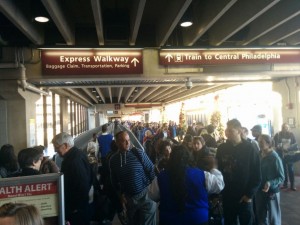The first time your baby ate solids, you didn’t throw a bone-in ribeye in front of her. You started small. Same here. To the extent that your geography and schedule can allow for it, choose a friendly airport, depart at the optimal time and do it on a plane that can seat you comfortably. Let’s break this down after the jump.
Introduction
The Itinerary
Flights and Seating
Packing
The Airport
Arrival
The Finish
Flight and Airport Choices
That first time out is ideally a short flight – maybe an hour to ninety minutes in the air. No connection. To the extent that you can manage it, starting or ending the trip at a smaller, slower airport is quite helpful.
Let’s take, for example, the calm scene at Portland International Jetport (PWM):
Contrasted against Philadelphia International Airport (PHL):
While I’ve cherry-picked some extreme examples, in my experience I’ve found PWM to look like the image above more often than not. Unfortunately, I can also say the same about PHL. It may be unavoidable on your trip in one direction, but if you can start from a calmer airport, you’ll be more prepared for the potential storm on the return.
As far as the timing of your flight goes, experience is going to guide your decision. All children are different, so I really cannot make any specific blanket statement about when to fly. I will simply offer some advice – fly during the periods of the day where your child is generally calm and not particularly needy. For a six month old, using my daughter as an example, the best time was in the evening with a departure time maybe 30 minutes prior to her normal bedtime. We would try to feed her, head to the airport and feed her again right before takeoff, so that she might get to sleep in her car seat and call it a night. It tended to work until she was close to the year mark, when we shifted to mornings – 6-8am departures. That happened not so much because she became fussy at night, it was more that she would insist on sleeping on you rather than in her car seat. She was most active at mid-day, so we tried to land by that time and let her run around the airport before continuing on. By all means, though, do your best to travel according to your own kid’s patterns.
One final mention that has more to do with your airport and aircraft choices than the flights or airlines themselves – try to avoid what I would consider the options that are horrible under ideal circumstances. For instance, any flight operated on a Canadair Regional Jet 200 is likely to be uncomfortable. You may board from the tarmac, which could involve a walk or a bus. The seats are tight and the overhead bins are small. I avoid Embraer 135/145 aircraft for similar reasons. If you are taking a flight on a regional jet, in my opinion there is nothing better than the ERJ 170/175/190. My experience on these is mostly with US Airways Express, but the E70/75 tend to feature a curtain bulkhead divider, meaning all of the legroom plus the under-seat storage. I might imagine it, but I think there’s an extra inch of seat pitch on some as well. Alaska Airlines’ 737 fleet is largely soft bulkhead as well, although there are some exceptions.
You may be wondering how to even determine the plane you’ll fly on, but thankfully most airlines are disclosing this when you search for your flight. On most airline websites, look at the “details” on the specific flight you’re considering and an aircraft type will often be listed as a 3 character code. If you see CRJ or CR2, that is the CRJ-200 that I previously mentioned. Similarly, E35/E45/E70/E75/E90 are the Embraer aircraft – and I’d again suggest skipping the E35/45. For “mainline” planes, which tend to be the larger jets that you think of when it comes to flying, 73x, 31x, 32x, where x is a number or character, denote the Boeing 737 or Airbus A319/320/321. That third character is simply to tell you the variant, such that 738 indicates the 737-800 – a useful one to know if you are flying Alaska Airlines, for instance. In general, these planes will all be roughly similar and certainly better than any CRJ-200 or Embraer 135/145. My personal preference above all other aircraft flown domestically is the E175 sitting in the bulkhead row, at least in the manner that US Airways has it configured. However, the Alaska Airlines 737-800 in the bulkhead is a close second. Finally, before you buy that flight, check SeatGuru for specifics on the flight – it is a great resource to see the seat map, aircraft type and reviews of each seat.
While aircraft swaps do happen, the odds are that you’ll fly on what’s listed.
Flying in the right seat
There are a lot of moving parts to choosing the right seats – airlines and aircraft vary, seating fees and policies are a factor, some of you might have status and score an upgrade while others are sitting in the back. I have two overarching points of advice that hope will serve you well –
1. If a first class upgrade is available to you, take it!
2. If you will be in coach, get the most legroom available
While a quick perusal of FlyerTalk will suggest that kids in first class are a divisive topic, my own personal experience – including a couple dozen segments in domestic first before my child’s second birthday – is that it really is a non-issue. Most passengers just leave you alone, while others will be outwardly friendly. I have yet to encounter the child-hating crank in a suit that I read about on various forums. It’s not to say they don’t exist, but the reality is, most people sitting in domestic first are people just like you who might have kids at home. I will also say, though, that it is your duty as a parent, no matter where you sit, to do your absolute best to keep your child calm and non-disruptive.
Beyond this, sitting in first has two major advantages. One is that you simply have more space. Sitting in the bulkhead also means that there is no seat in front to be kicked or grabbed, and we do often choose that if we clear an upgrade. The downside is that you do need to board early because you will have carry-ons, so do that and ask a flight attendant for help if you manage to not be seated near your things. We’ll cover more of this in a later installment, but I do want to make the point that the first class (or any) bulkhead is a good seat. The second advantage is the ratio of passengers to flight attendants. I can’t speak for all crews, but we’ve had some wonderful folks particularly on US Airways’ Republic-operated regional and Alaska Airlines’ mainline flights. It’s not to say you should expect them to do your parenting for you, but little things like providing distractions (cups, snacks) and just coming over and chatting make the experience all the better.
For the coach passengers, which is me most of the time, and probably most of you too, the more legroom you can get the better it will be for your little one. If possible, reserve a bulkhead row. I recommend this especially if your child is becoming mobile, as the extra legroom will provide enough space to walk within the confines of the row.
If you are flying American, United, Delta or JetBlue, consider buying up to their enhanced legroom product. Some of these buy-ups include early boarding, which will help you get settled and into the overhead. While it used to be the case that airlines had families board first, or at least very early, the only airline I still see doing that consistently as part of the pre-boarding process is Alaska Airlines.
As of yet, I haven’t mentioned seat fees for otherwise normal coach seats, but I unfortunately have to recommend that you simply pay them if it is the only way to pre-assign yourselves to sit together. I wish I could say differently, but the idea that the airline is blocking enough seats to put you all together at check-in or at the gate is not consistently true. I am also unaware of any airline policy stating that they will seat families together. It isn’t worth the worry and headache to show up to the airport without assigned seats together, and for me, it’s just part of the cost of family travel. I personally won’t book a flight unless I can get at least two seats together, and I’ll avoid booking when I can’t assign all three of us together unless that flight is really our only option.
All of this is, of course, just my opinion and certainly not the only right way to do this. You might even notice my preference for Alaska Airlines and US Airways Express’ Republic Airlines operated flights – they have earned my goodwill. If you have preferences, tips or tricks of your own, please share in the comments!





